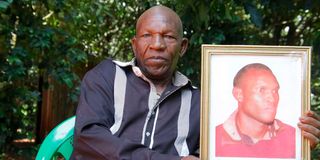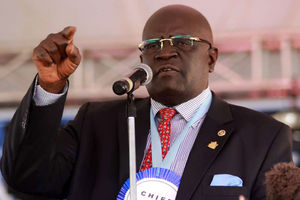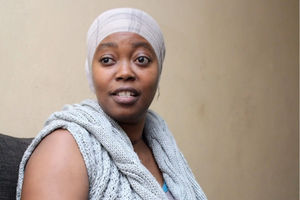
Mzee Benjamin Wachira holds a portrait of his son Samuel Kimani Wachira at Kariguini village in Nyeri County on June 15, 2024.
A cook who wrongfully underwent head surgery at Kenyatta National Hospital in 2018 died quietly three years later due to complications arising from the botched operation, Sunday Nation can reveal.
Mr Samuel Kimani Wachira had his head opened up during an operation on the night of February 19, only for surgeons to shockingly realise they had the wrong patient on the operating table after failing to find a blood clot in the brain. Mr Kimani’s procedure was supposed to be on the arm, not the head.
A horror mix-up of patient identification tags saw Mr Kimani mistaken for Mr John Nderitu, a motor bike accident victim who needed surgery to remove a blood clot in the head. It was his arm that was given attention instead in one of Kenya’s worst medical mix-ups to be revealed in public.
Hours into the operation, the surgeons were stunned to be told the man sprawled on the operating table wasn’t supposed to have his skull opened up and instead only needed a non-invasive treatment for swelling.
This week Sunday Nation tracked down Mr Kimani’s family who disclosed how the former cook at Pangani Girls School died on May 31 2021, three years after being discharged from KNH.
After discharge from hospital on March 7, 2018, following the botched operation that sparked public uproar, the family said Mr Kimani, a father of two, suffered ill-health thereafter and never regained his former self.
“When he returned, he was never the same, he started complaining of migraines, had seizures and would faint often,” his father, Mr Benjamin Maina Wachira recounted.
In his final days, Mr Kimani was battling post-traumatic stress disorder and persistent bouts of memory lapses, he added.
On the fateful day, his father recalled that they were harvesting macadamia nuts. Mr Kimani had climbed up one of the trees but hurriedly climbed down. He then collapsed. Some young men took him into the house. He never spoke again.
He was rushed to the Nyeri County Referral Hospital where he was admitted for three days and later died.
A death certificate indicated the cause of death for the 42-year-old was “cardiorespiratory arrest, status epilepticus, convulsive disorder and aspiration pneumonia.”
Continuous seizures
Status epilepticus refers to multiple or continuous seizures that last more than five minutes. Aspiration pneumonia occurs when food or liquid is breathed into the airways or lungs, instead of being swallowed. Aspiration cardiorespiratory arrest occurs due to life threatening obstruction to the airway.
A neurosurgeon, who spoke to Sunday Nation on condition of anonymity, and who is familiar with Kimani’s case, said the cause of death was consistent with complications that could arise from a botched head surgery.
The surgeon explained the interference with Kimani’s brain during the botched surgery could explain the seizures he experienced.
Status epilepticus and convulsion disorder as the cause of death, the doctor observed, is not surprising considering the trauma that his brain experienced. The doctor, however, added that the epileptic attacks could have been aggravated by other lifestyle habits.
In an earlier interview with Nation in 2018 after the surgery, Kimani had complained about intermittent headaches, his mind constantly frayed with confusion and dizziness.
Unable to work
His is a story characterised by tragedy and misfortune with the family protesting that Kimani never received follow up medical care by KNH.
Kimani was unable to continue with his job at the school as he could not withstand the workload of cooking for hundreds of students and being around too much heat, which he lamented affected him.
This prompted him to move back to his rural home in Karigu-ini village, Tetu Sub-County in Nyeri with his wife and two young children so that he could recuperate. But he never regained his health.
“When he came here, he had a lot of challenges. He was making a lot of noise and was not eating. Then he stablised but after sometime he started suffering from seizures and fainting,” his father recalled.
The family would later sue KNH management for medical negligence, an out-of-court settlement was reached but the Sh3 million compensation was mere tokenism for a young man whose brain had been damaged, according to his father.
“Was Sh3 million really enough for Kimani’s loss of his abilities, for someone whose brain was damaged and never recovered?” Mr Wachira posed. “He had a family and eventually died. It was never enough. It is equivalent to murder.”
Kimani’s grave is nestled behind a row of three wooden houses in Mr Wachira’s compound. A brown cross marks the grave where he was laid to rest, under the macadamia tree from which Kimani had a fatal fall.
On the fateful day in 2018, Kimani had gone to work at Pangani Girls School but failed to return home. It later emerged that a Good Samaritan found him by the roadside unconscious and took him to KNH.
That is how Kimani, who had no prior medical history, had ended up at KNH, tragically, on the same day as another patient unknown to him was due to be wheeled into theatre but whose fate would become intertwined with his.
Kimani had been received at the hospital unconscious on February 19, according to hospital officials.
On the other hand, Mr Nderitu had been found injured at Kahawa West, rushed to St Francis Hospital in Kasarani and later transferred to KNH on the night of February 18.
No identification tag
Relatives said during his entire stay in hospital, until discharge on March 7, no identification tag was put on their patient, an oversight that would set the stage for one of the most horrific surgery mix-ups at KNH.
An investigation by Members of Parliament found a nurse erroneously labelled the wrong patient — Kimani — setting off a disastrous chain of events that would lead to the cook being wheeled to the theatre for an unnecessary head surgery.
The confusion was worsened by the fact that the operating doctors had no prior contact with the actual head surgery patient, Mr Nderitu.
Those who assessed him and recommended surgery were not the ones who eventually conducted the operation.
Much later, the MPs’ inquiry would be told the cook at Pangani Girls School could not remember what happened to him, or how he had ended up at KNH.
February 19, 2018, was a routine day for a nine-member team that included the consulting doctor, nurses and neurosurgeons who were prepping for another life-saving operation for a patient— Nderitu — who had been brought in the previous day.
The team comprised Dr Michael Magoha (junior neurosurgical consultant), Dr Dave Mangar (neurosurgery resident, UoN), Dr Hudson Ng’ang’a (junior neurosurgery resident), Dr Mose Moraa (general surgical resident, UoN) and Dr Nelson Okedi (registrar, orthopedic surgery).
Others were Mr Malachi Odhiambo (assistant chief clinical officer-anesthetist), Ms Linet Makori (senior nursing officer), Ms Catherine Gakii (senior nursing officer) and Ms Mary Wahome (nursing officer).
Earlier, Dr Okedi had examined patient Mr Nderitu at the casualty and concluded a surgery was required to remove a blood clot in the head as revealed by a CT scan.
He then consulted a colleague, Dr Daniel Kanyatta, who concurred with his assessment.
They then recommended surgery and had a relative of the patient sign a consent form as is standard procedure.
It was at this point that Dr Okedi handed over the patient and his report to nurses to facilitate the next course of action.
Ms Wahome, a surgery ward nurse, was on duty on the evening of February 19 together with a team of four nurses, including Mr Gideon Mwangi.
It is Mr Mwangi who had received handover reports, including for Mr Nderitu who was due for neurosurgery, from the team in the previous shift.
Ms Wahome said the four nurses were overwhelmed, handling about 60 patients, and also responding to customer care queries. The handover was, therefore, not done physically and bed-to-bed as should have been the case.
Mr Nderitu’s case was among seven pending emergencies handed over to Ms Gakii.
His patient file had been brought to theatre at around 2pm but was not received since there was no blood.
Ms Gakii went about preparing other patients until around 9pm when she called Ward 5A for Mr Nderitu to be taken to the theatre since blood was now available.
Ms Wahome then went to the ward and called out the name “John Nderitu”.
Things go wrong
According to her testimony, a patient nodded in response, after which she went back to the station, prepared a label, and collected the file and antibiotics.
She went back to the ward with the porter, called out the name again and tagged the patient who nodded again in response.
What she did not know was that she had tagged Kimani as Mr Nderitu.
She informed the patient that he was going for surgery. The nurse testified that the seemingly confused patient nodded. That is where things began to go wrong.
At around 10pm in the theatre, Ms Wahome handed over the patient and file to her colleague, Ms Gakii.
Ms Gakii had greeted the patient but he had only nodded in response. The patient had already been labelled at this point, and together with the file and bio data, she had ticked the pre-operative checklist.
Thereafter, at around 10.50pm, Ms Gakii had called Mr Odhiambo to take over the patient for pre-surgery preparations.
The anaesthetist had perused the file and tried to talk to the patient who, however, had not been responsive.
He had checked all requirements including positively identifying the name of the patient through the label and file as well as checking the CT scan report.
The anaesthetist had then confirmed that blood was available, and checked pre-operative vital signs, including blood pressure, pulse and blood sugar levels.
Thereafter, the medics had wheeled the patient into the theatre room and set up monitoring equipment.
The anaesthetist had prepared medication and induced anaesthesia. They then displayed the CT scan on the board.
One last time, Dr Ng’ang’a, the neurosurgeon, in the presence of Dr Moraa, had consulted Dr Magoha on the need for surgery and he had concurred.
The patient had been shaved and positioned for surgery.
The surgery had commenced but the surgeons could not locate the clot. They had reconfirmed on the CT scan and called the ward to confirm if indeed they had the right patient.
At around midnight, the doctors had called Ms Gakii to confirm if the patient was the right one because findings were at variance with the CT scan.
She perused the file again and called Ward 5A to confirm. Everything matched the profile of Mr Nderitu.
The surgeons then called Dr Mangar, a senior registrar, who reviewed the scan and file. Dr Mangar could not also find the clot. They then called Dr Magoha who also reviewed the CT scan and file, patient positioning and site of surgery. Dr Magoha confirmed everything was correct.
He, too, could not find the clot. The doctors then decided to close the wound, and do an urgent CT scan to establish the dilemma.
But away from the theatre, something was not adding up to staff in the ward. At 2am on February 20, Ms Wahome’s colleague, Mr Mwangi, asked her of the whereabouts of patient Nderitu.
She informed him the patient was in theatre. At 6.30am, another nurse, Ms Miriam Mbela, reported on duty and asked Ms Wahome if the patient was taken to theatre.
It was at this juncture that Ms Wahome discovered she had taken the wrong patient to theatre. She immediately called trauma theatre and informed recovery ward nurse Gladys Wanjala.
Ms Gakii asked for the other file and discovered it belonged to a Mr Samuel Kimani.
Before the doctors could do another scan, the Ward 5A nurse reported the wrong patient, Kimani, was on the operating table in theatre. They then reported to their supervisors Dr Gichuru Mwangi, senior consultant, and Prof Nimrod Mwang’ombe, head of neurosurgery thematic unit.
After the surgical mishap, Prof Mwang’ombe led the neurosurgical team to review the two patients involved in the mix up.
It was decided that Mr Nderitu no longer needed surgery owing to his improved physical condition. Mr Kimani was noted to be stable and doing well post operatively and a decision was made to undertake neuro-checks every two hours.
Mr Amos Wachira, Mr Kimani’s brother, told MPs a social worker from KNH had called their father on February 22 and informed him that an unidentified patient was admitted at the facility.
A paper scribbled with the telephone number had been found on the patient.
A bill of Sh98,425 was subsequently waived as the case was deemed special.
“On the day we found Kimani in 2018, the hospital did not inform us he had been operated on. We only found him with a big scar on his head,” his widow told Sunday Nation.
Mr Nderitu, the patient at the centre of the surgical mix-up, and his relatives, appeared before the MPs probing the incident on March 14.
Mr Nderitu submitted that he was unemployed but survived on informal menial jobs. After the motor bike accident, he could not no longer work.
The committee report observed “he was generally slowly improving but still experienced bouts of headaches.”
The MPs heard nobody at the hospital or elsewhere had reached out to them since discharge on March 7.
Mr Nderitu and his family only heard about the mix-up of the two patients from a Dr Gichuru Mwangi, who attempted to address their concerns.
Mr Wachira, who appeared before the National Assembly’s Health Committee on March 14, told MPs that nobody at the hospital had reached out to them a week after his brother Kimani had been discharged on March 7.
An appointment for review had been set for March 19.








